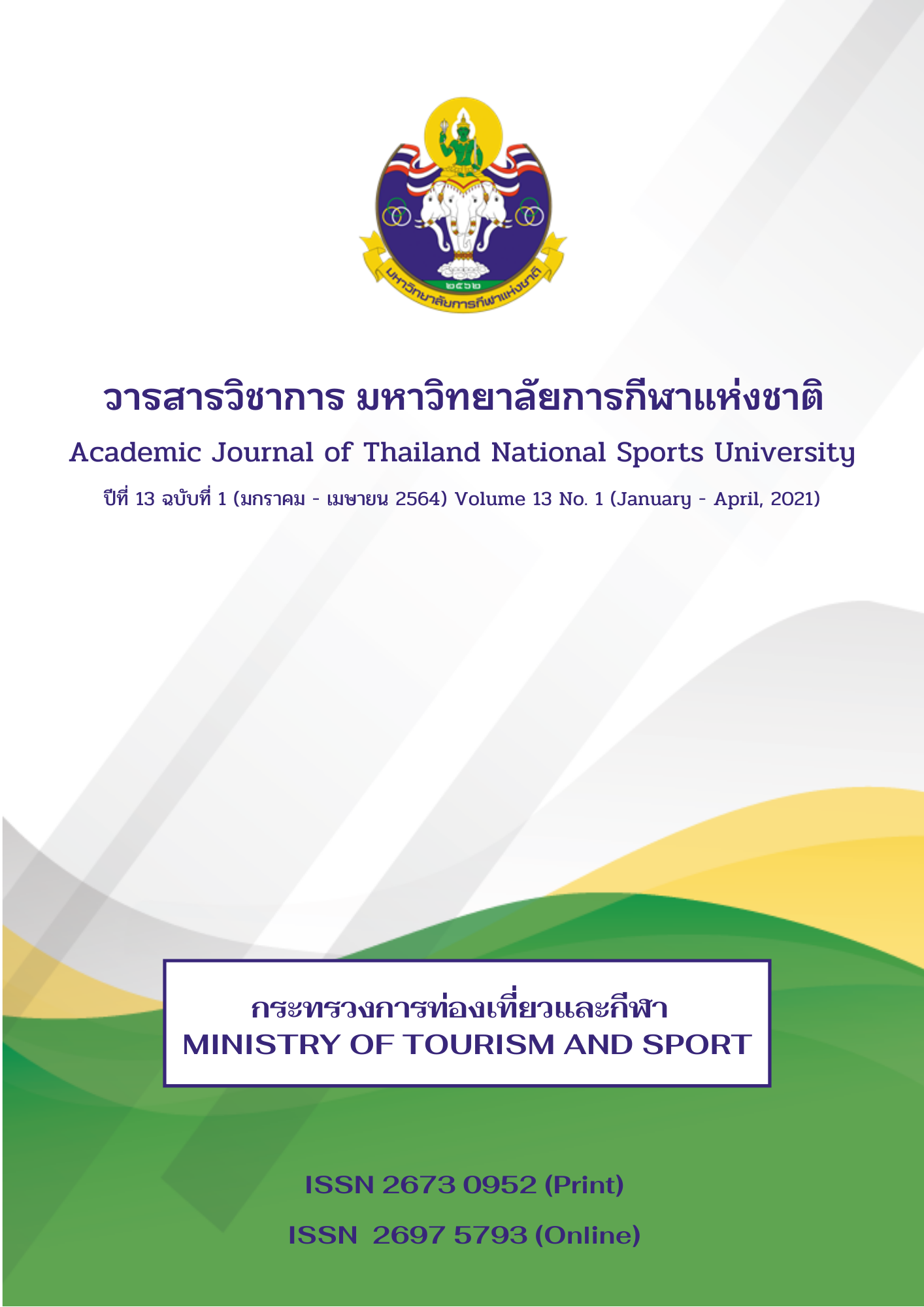AN APPLIED SOENG SA NAI EXERCISE TRAINING PROGRAM ON BLOOD PRESSURE AND BODY MASS INDEX OF ELDERLY FEMALES WITH HYPERTENSION
Main Article Content
Abstract
The objective of this quasi-experimental research was to study the effects of an applied Soeng Sa Nai exercise training program on blood pressure, body mass index and health related fitness of elderly with hypertension. The subjects were 60 elderly females with hypertension aged between 60-79 years old selected by purposive sampling method (criterion for selecting and sorting out was available). The two experimental groups divided by random sampling method were 30 subjects to be trained with an applied Soeng Sa Nai exercise training program and the control group of 30 subjects to spend daily lives habitually. The tools used in this research were: 1) An applied Soeng Sa Nai exercise training program created by the researcher and 2) Health assessment form. The data and variable describing were analyzed by using frequency, percentage, mean and standard deviation while hypothesis were tested by analyzing the variance of repeated measures ANOVA and ANCOVA at statistical significant level of .05.
The results revealed no significant difference at the level of .05 after 8 weeks and 12 weeks of experiment of an applied Soeng Sa Nai exercise training program on blood pressure and body mass index of elderly females with hypertension. However, this developed aerobic exercise training program with a moderate level can be used to enhance the physical fitness of the elderly people appropriately.
Article Details
The published article is a copyright of the Academic Journal of Thailand National Sports University. The passage appeared in each article in this academic journal is a perspective of each author which is not related to the journal. Each author is required to be responsible for all components of his/her own article. If there are any mistakes, each author must be responsible for those mistakes on his/her own.
References
Amonrat Niamsawan, Nongnut Oba and Somboon Tansupasawasdikun. (2012). Effects of Ponglang music aerobic exercise on physical fitness and blood pressure among the elderly with Hypertension. Journal of Nursing and Health Sciences, 6(2), 62-75.
Center for Continuing Pharmaceutical Education. (2018). Measurement of hypertension in the elderly. Retrieved from https://ccpe.pharmacycouncil.org/index.php?option=article_detail&subpage=article_detail&id=387
Chonticha Chantakeeree. (2015). The effects of using health folk songs and thai wand exercise training program on knowledge and health behaviors, blood pressure and well-being of hypertensive elderly. The Journal of Faculty of Nursing Burapha University, 23(4), 15-30.
Cohen, J. (1988). Statistical power analysis for the behavioral sciences (2nd ed.). Hillsdale, NJ: Lawrence Erlbaum Associates, Publishers.
Fagard RH. (1993). Physical fiitness and blood pressure. J Hypertension, 11(5), S47-S52.
Fagard RH. (1999). Physical activity in the prevention and treatment of hypertension in the obese. Med Sci Sports Exerc, 31, S624-S630.
Hamdorf PA, Withers RT, Penhall RK, et al. (1992). Physical training effects on the fitness and habitual activity patterns of elderly women. Arch Phys Med Rehabil, 73, 603-608.
Hoof V, Hespel P, Fagard R, et al. (1989). Effect of endurance training on blood pressure at rest, during exercise and during 24 h in sedentary men. Am J Cardiol, 63, 945-949.
Janjiraporn Wichai, Saisamorn Poldongnauk and Kittisak Sawanyawisuth. (2015). Hypertension. Khon Kaen Province: Srinagarind Hospital.
Kasamapron Bunmat & Tanida Phatisena. (2015). Effects of an exercise program with rubber chain by applying self-efficacy theory for blood pressure control among hypertension risky group. Proceeding of 34th The National Graduate Research Conference, 760-770.
Kelley GA, Kelley KS, Tran ZV. (2001). Aerobic exercise and resting blood pressure: A meta-analysis review of randomized controlled trials. Prev Cardiol, 4, 73-80.
Lee, IM, Shiroma EJ, Loblo, F, Puska P, Blair SN and Katzmarzyk PT. (2012). Effect of physical inactivity on major non-communicable diseases worldwide: an analysis of burden of disease and life expectancy. Lancet, 380(9838), 219-229.
Maliwan Saelai, Noppawan Piaseu and Ladaval Ounprasertpong Nicharojana. (2018). Effects of program promoting aerobic hula hoop exercise and nutritional education with social support on body mass index, waistline, and blood lipid in persons at risk of metabolic syndrome. Journal of Phrapokklao Nursing College, 29(1), 54-67.
Pescatello LS, Franklin BA, Fagard R, Farquhar WB, Kelley GA and Ray CA. (2004). American college of sports medicine position stand. Exercise and hypertenstion. Med Sci Sports Exerc, 36(3), 533-553.
Seamus P. W., Ashley Chin., Xue Xin., and Jiang He. (2002). Effects of aerobic exercise on blood pressure: A meta-analysis of randomized, controlled trials. Ann Intern Med, 136, 493-503.
Somjai Vinijkul. (2010). The effect of an exercise program applying the transtheoretical model on obesity in people in community of Bangplat District, Bangkok Metropolitan. Rama Nurs J, 16(3), 327-340.
Tachapon Tongterm, Waree Nantasing and Norapol Ramrit. (2019). The effects of an applied zeang-sa-nai exercise training program on blood pressure, body mass index and health-related physical fitness of elderly with hypertension. Complete Research Report, Sisaket Rajabhat University.
Thailand Information Center. (2018). Tumbon Yang Chum Yai. Retrieved from:
Whelton SP, Chin A, Xin X, He J. (2002). Effect of aerobic exercise on blood pressure: A meta-anaylsis of randomized, controlled trails. Ann Intern Med, 136, 493-503.


